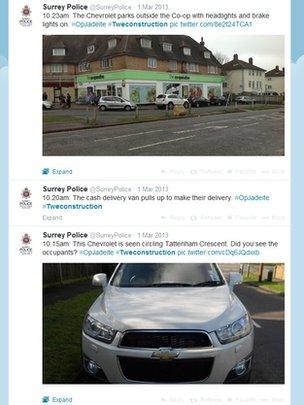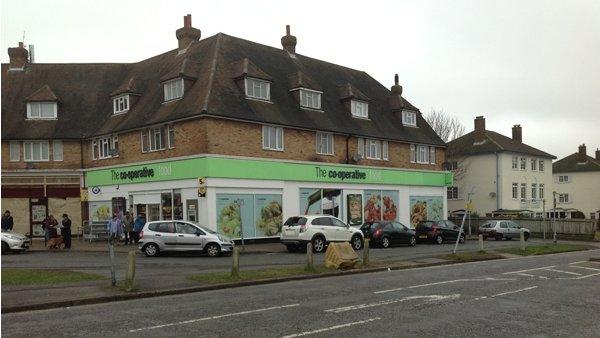Tweets that trapped Tattenham Corner armed robbers
- Published

The reconstruction started with the Chevrolet car seen circling Tattenham Crescent before the robbery
A Twitter reconstruction that helped build the case against a father and son team of armed robbers is being claimed as a "world first" by Surrey Police.
A series of tweets a month after the £45,000 raid outside the Co-op at Tattenham Corner in Epsom reached 53,000 people and generated 40 calls.
It helped gather information from people in the area at the time and eliminate suspects from inquiries.
Terrance and Lewis Clark have now been jailed at Guildford Crown Court.
Terrace, aged 50, was given a life sentence, while Lewis, 27, was jailed for 16 years.
Staff at the Co-op, who watched as cash delivery driver James Smith was attacked, said the robbery was terrifying.
The attackers pulled the trigger of a gun and when it failed to go off they used it to "pistol-whip" Mr Smith, leaving him with serious injuries to his face and hands.
The Clarks were both arrested within a week of the robbery on 30 January 2013 but were on bail for nine months while the police built their case.
The Twitter reconstruction was used alongside CCTV, financial investigations and automatic number plate recognition (ANPR).
Using the hashtags #tweconstruction and #opjadeite, the events of the morning of the robbery were tweeted in real-time on 1 March in a bid to trace further witnesses.
The reconstruction started at 10:15 GMT with pictures of a Chevrolet car seen circling Tattenham Crescent and continued through the attack on Mr Smith until 11:53 GMT when the car was found abandoned in North View Crescent.
Former detective Dave Lattimore, technical adviser for Teddington-based forensic science company LGC Group, said he wished Twitter had been available when he worked for Thames Valley Police.
He said he had never heard of a real-time reconstruction being used before but it was likely to be repeated by other forces, bearing in mind the number of Twitter followers they now had.
"It's a very clever technique," he said.
"If you do a Crimewatch reconstruction you've got to get people watching TV and then they've got to make the call.
"But people are carrying their smart phones round all day long.
"That is why you can get such a big response."
Police forces have long used Facebook, Twitter and their own websites to appeal for information but Mr Lattimore said there were many other uses of social media across the world
For example, Los Angeles Police Department used it to monitor the mood of crowds who gathered for Michael Jackson's memorial service at the Staples Centre as far back as 2009.

The reconstruction included a map of the getaway route used by the robbers' car
Dr Paul Reilly, of the University of Leicester's department of media and communication said UK forces increased the use of social media after the riots in August 2011 in London and elsewhere.
"In 2011 there was a lot of mining of social media for intelligence and to post images of people they were looking for," he said.
"It is now common practice for police to use social media.
"They are using it to respond to members of the public and monitoring Facebook and Twitter to help arrest and charge people."
He said he had not heard of a real-time Twitter reconstruction before the Tattenham Corner robbery.
"This does appear to be the first one but if something works and it could be of use to other forces they are likely to adopt it," he added.
"There is a lot of sharing of practice."
- Published30 October 2013

- Published10 October 2013

- Published27 June 2013

- Published21 June 2013
